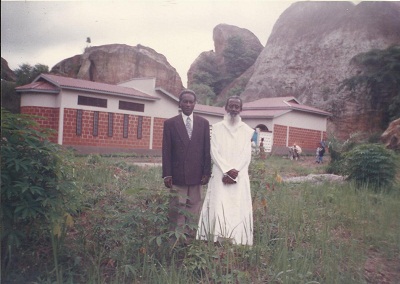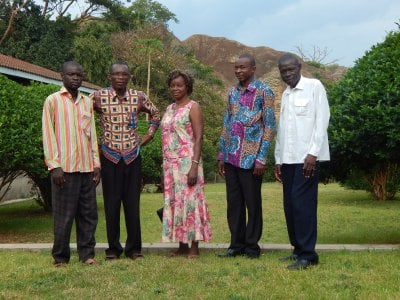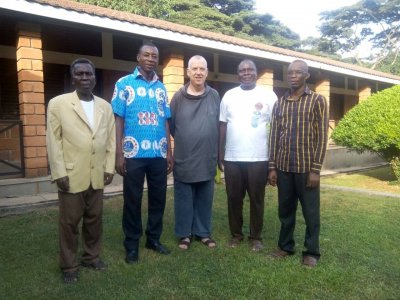Benedictine Oblates are lay men or women (or diocesan priests) who are striving to live the spirit of the Rule in their own call of life.
Every Oblate belongs to one particular monastic family and Kristo Buase has approximately twenty secular oblates who form part of the extended monastic family.
News of the Oblates
Meeting the new Prior in November 2015
Left to Right: Peter; Andy; Prior; Benedictus and Thomas
Br Joseph Asare
Our first secular oblate was Br Joseph Asare. He was formerly a diocesan hermit living on the rim of the crater at Lake Bosomtwi. In 1999 he came to live at Kristo Buase. Here you see him in front of the Kristo Buase Hermitage, opened in 2004, with his friend "Coach" from Kumasi.

The architect for the hermitage was Professor H. Nii Adziri Wellington, then Professor of Architecture at KNUST. Professor Wellington has agreed to be our architect for the Church and Guesthouse projects. The chapel on the left is used by the community on recollection days, and by retreat groups.

Here is a more recent photo of Br Joseph. He celebrated his 90th birthday on the 21st September 2014.

The photograph shows a group of our friends and oblates from the Techiman chapter. Pictured here: Anthony, Thomas, Gertrude, Philip and Sergius.
Benedictine and Cistercian Monasteries in West Africa
There are many monastic houses in the sub-region which welcome guests for retreats or periods of quite spiritual reflection. Their contact details can be found in the following Directory:
directory-of-west-african-monasteries.pdf
The Rule of St Benedict
The following file is extracted from Kristo Buase's edition of the "Life and Rule of St Benedict". It gives a synthesis of the spiritual teaching of the Rule, prepared by Dom Cuthbert Butler for the Novices of Downside Abbey. The text has been translated into English from the Latin original:
abbot-cuthbert-butler-heart-of-the-rule.pdf
Below is the Sankt Gall text of the Rule of St Benedict in Latin, transcribing one of the earliest manuscripts of the Rule that has come down to us. It was prepared by the monks of Montserrat in Spain. Apologies for the lack of formatting:
s-benedicti-regula-monachorum.pdf
Commentary of the Rule of St Benedict
You will notice this is a work still in process! My intention is to gradually post chapters of the Rule in this section with notes drawn from the commentaries of three Benedictine scholars: Terence Kardong, Basil Steidle and Abbot Holzherr.
The Prologue:
Liturgy
For reasons of copyright we cannot post our office on line, but it is possible to improvise if you wish to pray with the psalms using a Benedictine arrangement. The following file gives three authorised psalm-schemes: Schema A, from the Rule, together with Schema A2, which is a modification of St Benedict's arrangement of the psalms in RB 8-20 with the psalms spread over two weeks and the office of Prime eliminated; Schema B (the psalm-scheme we use at Kristo Buase, which is also widely used in European Benedictine monasteries) has the psalms spread over a one week cycle. The chart includes variants which were approved for our Congregation by the Holy See in 2011. Schema C was originally prepared for Cistercian monks: it has a lighter load of psalms since the psalmody is spread over two weeks and one of the little hours is omitted:
Psalterium Monasticum, Schema B, PDF
If you can read Latin, here is the text of Vigils for Ordinary Time:
ad-vigilias-psalterium-monasticum-schema-b.pdf
The following file has the Anglican Common Worship Psalter, which has some very beautiful turns of phrase, adapted to the numbering scheme of the Catholic Liturgy. It can be used with the tables above, the psalm breaks for Schema A and Schema A2 are indicated in the margins. I have started adding antiphons from the Psalterium Monasticum but will need to come back to this later to complete it. To adapt this to more readily available liturgical books, try inserting this psalmody to the texts given either in the Roman Office or Common Worship: Daily Prayer
This is an order for Compline, the last office of the day, using the Common Worship texts with the psalms of our Benedictine Schema B:
If you prefer the printed page, I suggest you order the official new Liturgical Psalter we use at Kristo Buase and Prinknash: The Revised Grail Psalms: a Liturgical Psalter (Singing Version), Chicago 2010. ISBN- 978-1-57999-838-7. It is available on line from Conception Abbey, Missouri, or through the GIA Publications website in the US. Here is a single A5 sheet for Schema B which can be printed, folded in half and used as an insert in the book:
Our Vigils Scripture readings follow the two-year Monastic Lectionary. The text is the New Jerusalem Bible. This is the current file for Year 2, Lent:
scripture-lectionary-lent-yr-2.pdf
And these are the corresponding second nocturn readings from the Fathers. These readings are used at Vigils and normally provide a spiritual commentary on the scripture reading used at the end of the first nocturn. I am grateful to Fr Stephen Holmes for the contents of this file:
patristic-lectionary-lent-yr-2.pdf
Lectio Divina

'Sir,' the woman said, 'you have no bucket and the well is deep, so where will you get "living water"?' - John 4:11.
A Practical Guide to Lectio Divina
The following is a list of 50 books which are recommended reading for novices and juniors at Kristo Buase Monastery. It covers many of the most important works of monastic spirituality from the Desert Fathers to contemporary monasticism in modern English translations. The majority are still in print, others are probably to be found on www.abebooks.co.uk :
a-practical-guide-to-lectio-divina.pdf
John Cassian
The Oblates' annual retreat this year focussed on some passages from the Conferences and Institutes of John Cassian (5th century) which help to clarify what St Benedict meant by "Purity of Heart". These are the texts we used, taken from the NPNF translation of Cassian:
cassian-conference-1-the-goal.pdf
2-admission-of-the-one-who-renounces.pdf
4-humility-frees-from-impurity.pdf
The English Mystics
It was Fr Augustine Baker, the 17th century Welsh Benedictine, who brought the spiritual teaching of the English Mystics back into currency. His great work 'Holy Wisdom' (Sancta Sophia) draws deeply on this tradition. Abbot Cuthbert Butler of Downside, one of the major figures of the monastic revival in the 20th century, re-read 'Holy Wisdom' every Lent for more than 50 years.
augustine-baker-holy-wisdom.pdf
Julian of Norwich's "Revelations of Divine Love", written down at the end of the 14th century, were transcribed and circulated in the seventeenth century by Fr Augustine Baker's editor; Dom Serenus Cressy, OSB. There are many modern translations in print.
julian-of-norwich-revelations-of-divine-love.pdf
And this is the text of the "Cloud of Unknowing", also from the 14th century and still often quoted in modern books on prayer:



